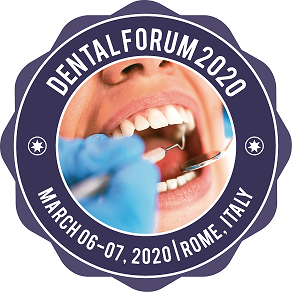
Nina Cebalo
University of Zagreb, Croatia
Title: The effect of transcoutaneous electrical nerve stimulation on pain control and anxiety reduction during dental procedure in children 9-14 years old
Biography
Biography: Nina Cebalo
Abstract
OBJECTIVE: The aim of the study is to examine the
eff ec􀆟 veness of the Transcoutaneous Electrical Nerve
S􀆟 mula􀆟 on in reducing pain and anxiety during a
dental procedure. The method of Trancoutaneous
Electroneuros􀆟 mula􀆟 on is based on the principle of
Electroanalgesia, where s􀆟 mula􀆟 on of A nerve fi bers
occurs. S􀆟 mula􀆟 on of the A fi bers blocks C fi bers
responsible for transmission of pain at higher levels of
the nervous system. Transcutaneous Electrical Nerve
S􀆟 mulator (TENS device) works on reduc􀆟 on of acute
and chronic pain, stress, tension, poor circula􀆟 on and
fa􀆟 gue. Similarly, it can be used to manage pain during
various dental procedures, as well as pain due to various
condi􀆟 ons aff ec􀆟 ng the maxillofacial region. It can also
be used as a distrac􀆟 on or placebo mechanism in order
to reduce stress and anxiety during dental procedures.
MATERIALS AND METHODS: During the fi rst visit
pa􀆟 ents will be classifi ed based on dental status
examina􀆟 on. Based on the need for restora􀆟 ve
interven􀆟 on Class I on the fi rst permanent molar and
age between 9 and 14 years, pa􀆟 ents will be randomly
selected into three groups: 1) group A of 40 examinees,
on whom there will be no anesthesia applied; 2) group
B of 40 examinees, on whom the TENS device will be
applied; 3) group C of 40 examinees who will receive
local anesthesia. Anxiety levels will be measured on all
three groups of pa􀆟 ents before and a􀅌 er the procedure.
Level of anxiety will be measured with the help of tests
for anxiety and pain: ASI (Anxiety Sensi􀆟 vity Index),
Picture Scale of Self-assessment (Self-Assessment
Manikin Scale), Norman Corah Dental Ques􀆟 onnaire,
CFSS - DS (Children`s Fear Survey Schedule - Dental
Subscale), and Visual Analogue Scale (VAS).
RESULTS: The hypothesis is that local anesthesia will
act as an analge􀆟 c in order to perform the prodecure
without pain and that the TENS device will act equally
or less eff ec􀆟 ve on pain and anxiety in rela􀆟 on to
local anesthesia. The expected result is that the TENS
device will successfully achieve mild analgesia and act
anxioly􀆟 c during the fi rst visit. The assump􀆟 on is that
only one treatment with TENS advice will be enough in
order to reduce anxiety. Expected scien􀆟 fi c contribu􀆟 on
of measuring stress levels with stress-ques􀆟 onnaires in
pa􀆟 ents will give a broader view of connec􀆟 on and the
impact of psychological stress on the manifesta􀆟 ons of
anxiety and pain control.

